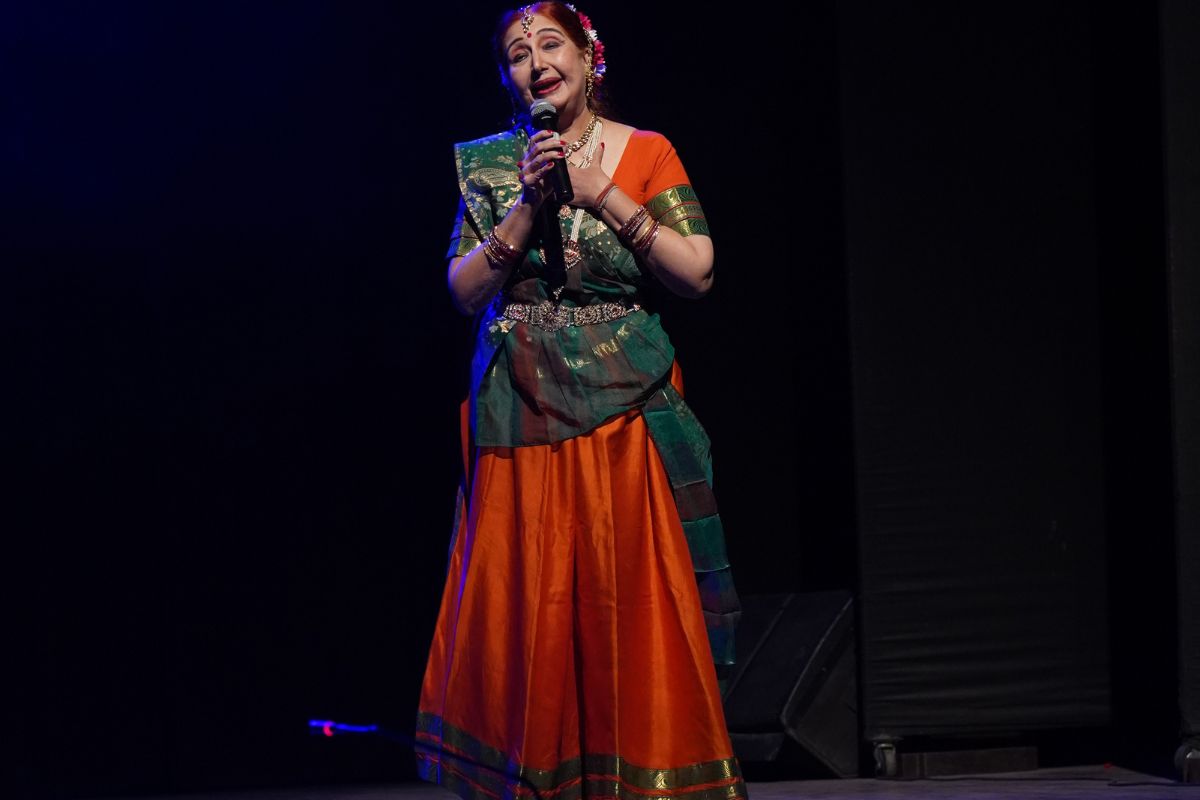Ananda Chandrika presented their new Kathak creation, ‘Banshi- the Mellifluous Flute’ at Rabindra Sadan, Kolkata, recently. The concept, choreography, and direction of Banshi were by Guru Amita Dutt; the music composition was by Chandrachur Bhattacharjee; and the dancers who performed in Banshi were Amita Dutt, Shramana Chattopadhyay, Rina Pyne, Pampa Ray Biswas, Pampa Paul, Sharmistha Chakraborty, Swarnali Moulick, Bidisha Jana, Aisharjya Bhadra, and Manjima Roy. The production was supported by the Ministry of Culture, Govt. of India, Sangeet Natak Akademi, La Opala RG Ltd., and K.C. Das.
The main production was preceded by Anga Vilas, a beautiful choreographic presentation consisting of abstract dance, which was performed by thirty talented young students of Ananda Chandrika under the direction of Amita Dutt. To quote Guru Amita Dutt: “Since the evening featured three generations of Kathak dancers, all from Bengal, it heralded what, in time to come, will be called the Bengal Gharana of Kathak.”
Flute music has dominated the Indian imagination for centuries, inspiring innumerable works of art of all genres. This choreographic presentation has captured the diverse and all-encompassing magnetism and charisma of the mellifluous flute. All the dance pieces were anchored on recreations of timeless Hindi and Bengali lyrics, composed by legends, and were set to Kathak, employing both the abstract and expressive aspects of this dance form.
Advertisement
The opening number set to Ravindra Jain’s Shyam Teri Bansi elegantly portrayed the plight of Meera, who knows that the flute is being played for Radha but is still lured by its melody, even at the cost of being defamed by everyone. The Bhakti bhava and anguish of Amita Dutt as Meera contrasted well with the jovial temperament of the women of Vraja, who are full of gleeful mockery.
The piece Gahana Kusuma Kunja Maajhe Mridula Madhura Banshi from Gurudev Rabindranath Tagore’s ‘Bhanusingher Padavali’ ably captured the role of the flute and its mesmerising effect on all devotees. Though unseen, the flautist had spread the alluring effect of the melody. Amita as Radha brought alive the conflict in Radha, who is not sure whether the flute is being played in the forest or in her own mind: Sakhi oi bujhi Banshi baaje. Radha’s dilemma was contrasted well with the sprightly movements of her sakhis, or friends, who were unaware of the sound of the flute and yet pretended that they could hear it, only to console Radha.
Salil Chowdhury’s timeless lyric Banshi keno gai poured out its melancholic tune expressed in the language of Kathak, which was pensive, and the vain search of the flautist was touching.
The image of Krishna was symbolically brought alive through Tagore’s Ogo shono ke bajai. The beauty of spring, graceful dance, and the joy of experiencing a strong bond with the flute and its alluring player were captured delightfully. The spirit of folk music and dance was seen in the sprightly presentation of Sachin Dev Burman’s song Banshi Shune ar kaj nai. It was interesting to witness the blend of Kathak rhythm and movements with the snake charmer’s melody and the expression of exasperation at the seductive quality of flute music.
Then came the dance set to Tagore’s Ekhono taare Chokhe dekhini sudhu Banshi shunechi. The search for the flute player is never-ending, and yet we cannot withdraw from our constant quest for the flute, for it symbolises eternity, which we all endeavour to reach.
Rahul Dev Burman’s “Banshi Shune ki Ghare Thaaka Jaaye” was the grand finale. Splendid choreography, brilliant dancers, a galaxy of rhythmic variations and gestures, and the mythological context of Radha and her sakhis were superbly blended to make this piece outstanding.
Bansi was impressively choreographed and danced. Excellent background music and colourful costumes, along with the stage setting with flutes and peacock feathers and imaginative light design, as well as the clear and precise introductions to the dance items by Amita Dutt, kept the audience glued to their seats. It was nice to see the huge Rabindra Sadan Hall jam-packed.
The writer is a senior dance critic
Advertisement












